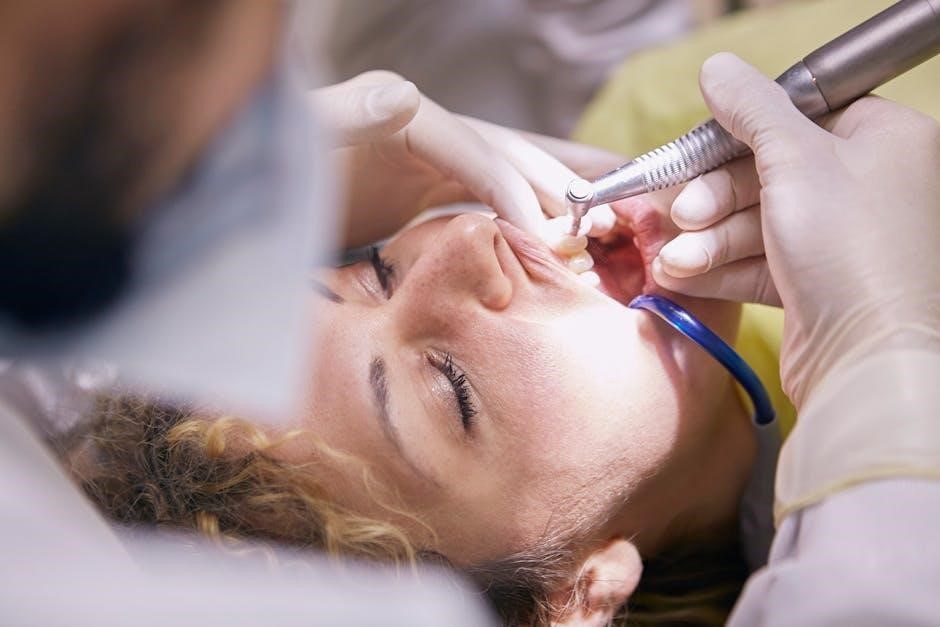Boiling a Mouthguard: Instructions for a Custom Fit
Achieving a custom fit for your mouthguard is crucial for optimal protection and comfort. The boil-and-bite method uses boiling water to soften the mouthguard‚ allowing you to mold it precisely to the contours of your mouth.
Boil-and-bite mouthguards are a popular and accessible option for athletes seeking customized protection without the expense of a dentist-fitted guard. These mouthguards are typically made from a thermoplastic material that becomes pliable when heated. This allows the user to mold the softened material around their teeth‚ creating a snug and personalized fit that enhances both comfort and safety. The process involves submerging the mouthguard in boiling water for a specific time‚ then carefully placing it in the mouth and biting down to create an impression of the teeth.
This method offers a convenient way to achieve a relatively custom fit at home‚ offering a balance between affordability and effectiveness in protecting against dental injuries during sports and other activities. Always refer to the manufacturer’s instructions for the best results.

Materials Needed for Fitting
To properly fit your boil-and-bite mouthguard‚ gather these essential materials: a new mouthguard‚ a saucepan for boiling water‚ a slotted spoon‚ a mirror‚ a timer‚ cold water‚ and a clean towel.
Mouthguard‚ Saucepan‚ Water‚ Slotted Spoon‚ Mirror‚ Timer‚ Bowl of Cold Water‚ Towel
First‚ you’ll need the mouthguard itself‚ preferably a boil-and-bite type made from thermoplastic material. A clean saucepan‚ filled with enough water to submerge the mouthguard‚ is essential for the softening process. Use a slotted spoon to safely retrieve the heated mouthguard from the boiling water. A mirror will help you align the mouthguard correctly in your mouth during molding.
A timer is crucial for accurately timing the softening and cooling phases. Prepare a bowl of cold water to quickly cool and set the shape of the molded mouthguard after fitting. Finally‚ have a clean towel on hand to dry the mouthguard and your hands‚ ensuring a hygienic fitting process and preventing slips.
Having all these materials readily available ensures a smooth and efficient mouthguard fitting experience.

Step-by-Step Boiling and Fitting Instructions
Follow these detailed steps to properly boil and fit your mouthguard for a comfortable and protective fit. Accurate timing and careful molding are key for optimal results‚ so pay close attention.
Boiling the Water: Fill and Heat
The first step in customizing your mouthguard involves preparing the water for the softening process. You will need a clean saucepan‚ filling it with approximately 3 to 4 inches of fresh‚ potable water. Ensure the saucepan is placed on a stovetop burner that is appropriately sized for the pot’s base.
Next‚ turn the burner to high heat‚ allowing the water to reach a rolling boil. A rolling boil is characterized by rapid bubbling and vigorous steam production. Once the water has reached this stage‚ it’s crucial to carefully remove the saucepan from the heat source. This step prevents the mouthguard from overheating.
Finally‚ let the water stand for precisely 30 seconds. This brief cooling period ensures the water is hot enough to soften the mouthguard effectively‚ but not so hot that it will cause damage or distortion to the material. This step is essential for achieving the perfect mold.
Submerging the Mouthguard: Time and Technique
With the water properly heated and allowed to cool slightly‚ the next crucial step involves carefully submerging the mouthguard. Using a slotted spoon or similar utensil‚ gently lower the mouthguard into the hot water. The ideal submersion time typically ranges from 12 to 60 seconds‚ depending on the manufacturer’s specific instructions and the type of mouthguard.
Refer to the packaging for the precise recommended time‚ as exceeding this duration can lead to deformation or damage. While submerged‚ ensure the mouthguard doesn’t directly touch the sides or bottom of the saucepan to prevent uneven heating. If your mouthguard has a strap‚ use it to hold the guard in the water‚ carefully following the manufacturer’s guidelines.
Once the appropriate time has elapsed‚ promptly remove the mouthguard from the water using the slotted spoon. Handle it with care‚ as it will be hot and pliable at this stage.
Molding the Mouthguard: Biting and Shaping
After removing the softened mouthguard from the hot water‚ it’s time to carefully mold it to your teeth. Allow it to cool for a few seconds‚ just until it’s comfortable to handle but still pliable. Position the mouthguard over your upper teeth‚ aligning it carefully for a proper fit. Bite down firmly‚ ensuring your molars engage first‚ followed by your front teeth.
Bring your lower jaw forward slightly to align with your upper teeth. Use your fingers and tongue to press the mouthguard against the inside and outside surfaces of your teeth‚ shaping it to the contours of your mouth. Create suction by gently sucking in air‚ helping the material conform snugly. Hold this biting position for 20-30 seconds to ensure a good impression.
Cooling and Setting the Mouthguard: Cold Water Immersion
Once you have molded the mouthguard to your teeth‚ it’s crucial to quickly cool and set the shape. Carefully remove the mouthguard from your mouth and immediately immerse it in a bowl of cold water. Ensure the mouthguard is fully submerged for at least 30 seconds‚ or as instructed by the manufacturer. This rapid cooling process hardens the thermoplastic material‚ locking in the custom fit you created.
The cold water immersion prevents the mouthguard from deforming and ensures it retains its shape. After the cooling period‚ remove the mouthguard from the water and check the fit. It should feel snug and secure against your teeth‚ without any discomfort. If adjustments are needed‚ proceed to the next step.

Adjustments and Refitting
If the mouthguard doesn’t fit perfectly after the initial molding‚ adjustments can be made. This typically involves reheating the mouthguard and repeating the molding process for a more precise fit.
Reheating for Adjustments
If your mouthguard doesn’t quite fit right after the initial fitting‚ don’t worry; adjustments are possible! Reheating allows you to soften the thermoplastic material again to refine the fit. First‚ bring water to a boil‚ similar to the initial fitting process. However‚ this time‚ you’ll only need to submerge the mouthguard for a shorter duration‚ typically around 10-15 seconds‚ to soften it without over melting.
Carefully remove the mouthguard with a slotted spoon and allow it to cool slightly‚ just until it’s comfortable to handle. Then‚ reinsert the mouthguard‚ focusing on the areas that need adjustment. Use your fingers to gently mold and shape the mouthguard around those specific spots. Bite down firmly‚ ensuring proper alignment and a secure fit. After molding‚ immediately cool the mouthguard in cold water to set the new shape. Remember to always follow the manufacturer’s specific instructions for reheating and adjustment to avoid damaging the mouthguard.
Important Considerations and Warnings
Prioritize safety! Always follow manufacturer’s instructions meticulously to prevent damage or injury. Exercise caution when handling boiling water and heated mouthguards‚ and ensure the mouthguard fits properly to maximize protection.
Following Manufacturer’s Instructions
Adhering to the manufacturer’s instructions is paramount for achieving a safe and effective custom fit when boiling a mouthguard. Different brands and models may have specific requirements regarding water temperature‚ submersion time‚ and molding techniques. Disregarding these guidelines can lead to a poorly fitted mouthguard‚ compromising its protective capabilities.
Always read the instructions carefully before beginning the fitting process. Note the recommended boiling time‚ as exceeding it could damage the mouthguard’s structure. Also‚ pay attention to any specific molding instructions‚ such as how to bite down or shape the mouthguard with your fingers.
Following the manufacturer’s instructions ensures that the mouthguard retains its integrity while providing a comfortable and secure fit. This step is crucial for maximizing protection during sports and other activities.
Safety Precautions During Boiling and Molding
Prioritize safety during the boiling and molding process to prevent burns and ensure a successful fitting. Use caution when handling boiling water to avoid scalding. Employ a slotted spoon or similar utensil to safely submerge and retrieve the mouthguard‚ minimizing the risk of direct contact with hot water.
Allow the mouthguard to cool slightly before placing it in your mouth to prevent burns to your gums and soft tissues. Test the temperature carefully before inserting it. Avoid excessive biting pressure during the molding stage‚ as this could damage the mouthguard or cause discomfort.
If you have braces‚ consult with your orthodontist before fitting a mouthguard‚ as special considerations may be necessary. Supervise children during the boiling and molding process to ensure they follow safety guidelines.

Mouthguard Care and Maintenance
Proper care and maintenance are essential for extending the lifespan of your mouthguard and ensuring its continued effectiveness. After each use‚ rinse the mouthguard thoroughly with cold water to remove saliva and debris. Use a mild soap or mouthguard cleaner for a more thorough cleaning‚ ensuring all residue is rinsed away.
Store the mouthguard in a ventilated case to prevent bacterial growth and odor buildup. Avoid storing it in direct sunlight or high temperatures‚ which can warp the material. Periodically inspect the mouthguard for signs of wear and tear‚ such as cracks or tears‚ and replace it as needed.
Bring your mouthguard to your dental checkups so your dentist can assess its fit and condition. With diligent care‚ your mouthguard will provide reliable protection for your teeth and gums.
